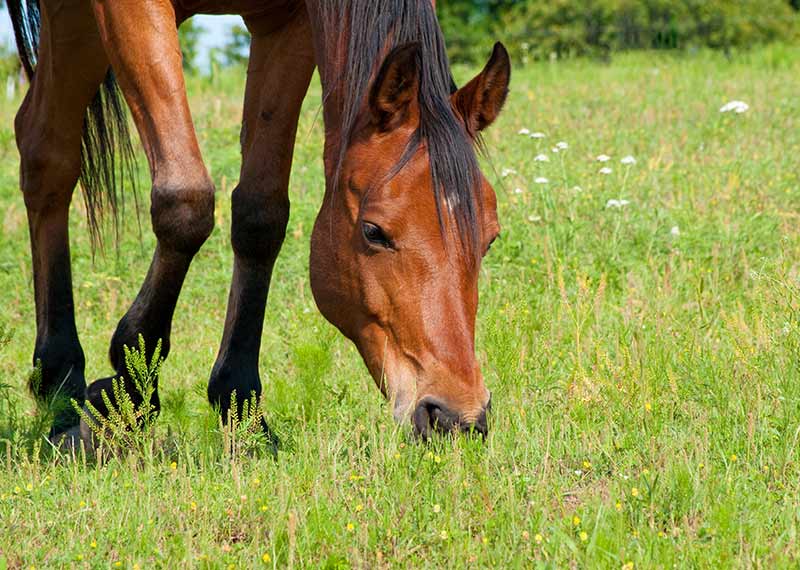
The lower limb of a horse is a fragile structure that is constantly busy and is put under a lot of stress! As a result, it can be prone to many conditions.
Common conditions
Tendon problems:?? Tendons are the structures by which the muscles attach to bones. As the muscles become tired, they contract and relax less efficiently – this puts the tendons under more strain and can result in inflammation and injury of the tendon.
Check your horse???s legs regularly for signs of tendon damage, especially after heavy or fast work. Signs of tendon damage include heat, swelling, pain and lameness
Ligaments: Ligaments are structures that attach bone to bone. They are found around joints, supporting the joint movement and protecting it from injury. However, if the joints are put under excessive strain the ligaments themselves can become damaged leading to lameness.
The most common ligament injuries we see in the front limb are in the collateral ligaments which support the coffin joint and the suspensory ligament. Fortunately, suspensory injuries in the forelimb tend to recover very well given the correct recovery programme.
Navicular syndrome: The navicular bone is found in the heel area of the horse???s foot. Navicular syndrome results from a degenerative change in the navicular bone and/or its associated ligaments and bursa (a fluid-filled structure around the bone).
Horses with Navicular syndrome experience pain in their front feet and as a result develop an uncomfortable gait and lameness. With correct veterinary and farrier care, horses can often continue to be actively ridden.
Laminitis: The laminae are sensitive structures that form the inner layer of the horse???s hoof wall and connect the wall to the pedal bone (the main bone within the foot). In the condition of laminitis, the blood flow to the laminae is disturbed causing swelling, inflammation and severe pain. Left untreated, the laminae become starved of blood and start to die.
The laminar support of the pedal bone may become insufficient and the bone can drop or rotate which makes the situation even more serious. If you are worried about your horse suffering from laminitis, it???s important to call your vet immediately.
Arthritis: Arthritis is inflammation of the soft tissues of a joint (cartilage, membranes) and it can result from acute trauma or from wear and tear over a long period. Arthritis causes stiffness and pain in joints and as result lameness. When arthritis is more advanced and bony changes develop on the joint then it is called ???osteoarthritis???- in these cases, the changes to the joint are visible on x-ray and may even be seen and felt on the outside.
Treatment of arthritis can involve the use of anti-inflammatory drugs, either injected directly into the affected joint(s) (most often steroid) or by adding to the food (most commonly ???bute???)
Foot Abscesses: A foot abscess is often the cause of a sudden severe lameness with no immediately obvious cause. In other cases, however, an abscess can take several days to develop and in these cases presents as a gradually worsening lameness.
Abscesses can occur when a bruise or corn becomes infected, when a nail or stone punctures the sole or when dirt or infection gets embedded in the hoof. The only way to effectively treat an abscess is for a vet or farrier to ???pare it out??? (i.e. drain it) and for the resulting hole to be kept protected and clean until it has healed.
Vet check
Laminitis isn???t only found in overweight ponies! Causes can include:
- Stress
- Concussion
- Obesity
- Blood poisoning (toxaemia)
- Cushing???s disease
If you are concerned about your horse???s welfare it???s best to get your vets advice. The vet will often ask you to trot the horse when assessing lameness.
Make sure you:
- Have a hard flat surface
- Line the horse up with the vet and trot in a straight line
- Give the horse enough slack on the rope so that the vet can observe head movement – when the horse???s head bobs in trot it is compensating for a loss of balance through lameness.
- Trot at a working pace – too fast or too slow and the lameness becomes less apparent!
Avoiding lameness
The best way to preventing lameness in your horse is to make sure you warm your horse up before exercise and cool it down slowly afterwards. Other ways include:
- Pick your horses feet out (and check them thoroughly) at least once a day
- Have your horses feet trimmed or shod every 5 ??? 6 weeks by a registered farrier
- Avoid exercise on excessively hard or soft ground
- A vet endorsed joint supplement can help reduce the onset of joint problems in older horses
- Keep paddocks clear and tidy without debris
- Check your fencing regularly to avoid escapes


